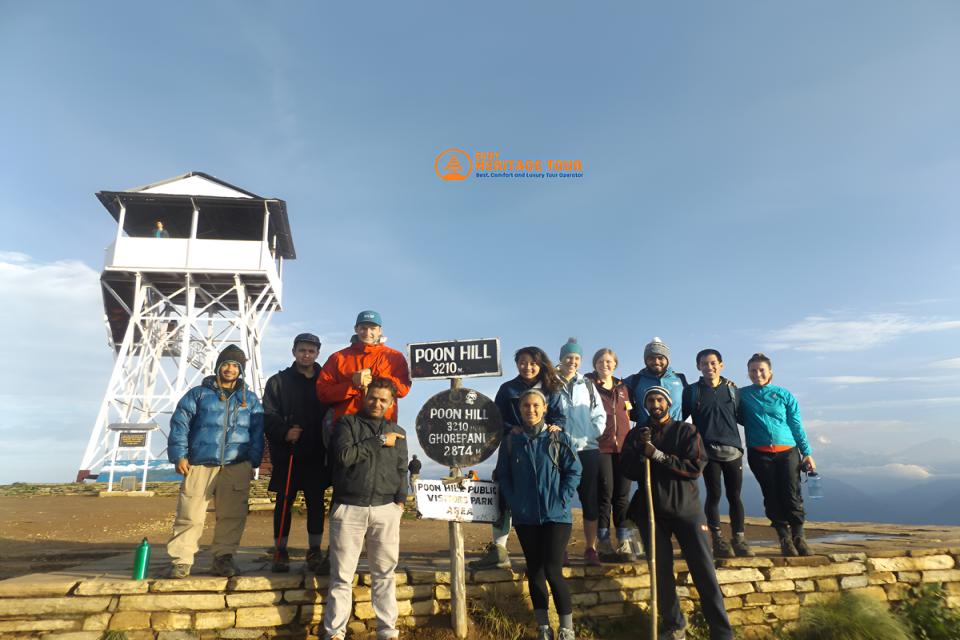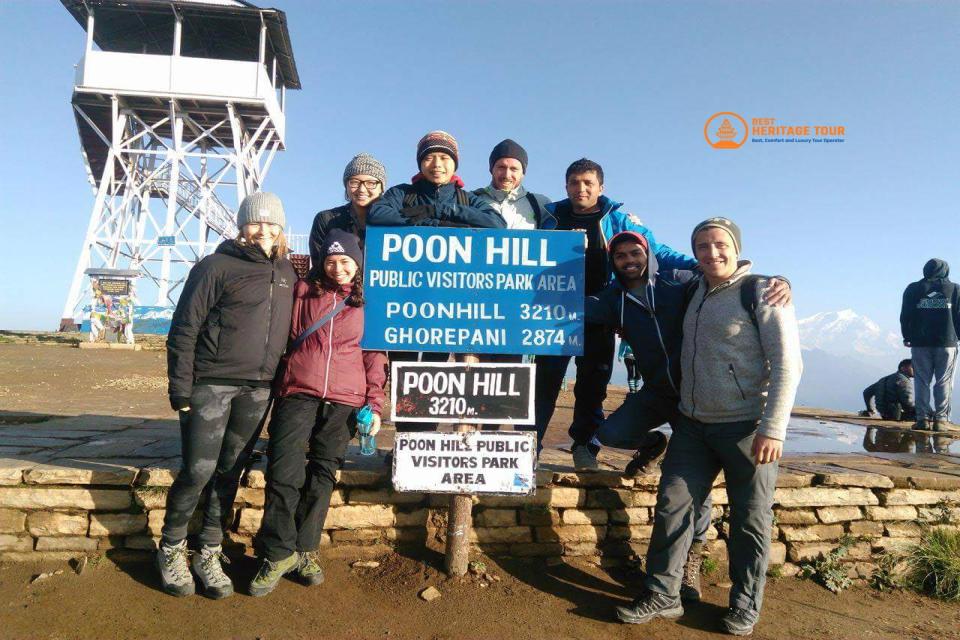The Poon Hill Trek is one of Nepal’s most cherished trekking routes, widely praised for its stunning mountain panoramas and cultural richness. Nestled in the Annapurna region, this trek offers adventurers a chance to witness the majestic peaks of Annapurna and Dhaulagiri, along with vibrant local villages, rhododendron forests, and unforgettable sunrises. But before you set off on this journey, you might be wondering: how difficult is the Poon Hill trek really?
In this comprehensive guide, we’ll break down the physical and logistical demands of the trek, explore the terrain and altitude, and help you decide if it’s the right adventure for you. We’ll also introduce you to two popular trekking options available through Best Heritage Tour - the full Poon Hill Trek from Kathmandu and the shorter Ghorepani Poon Hill Short Trek from Pokhara - giving you all the details you need to choose your perfect Himalayan escape.
Understanding the Poon Hill Trek Difficulty
Trek Terrain and Elevation
The Poon Hill trek is widely considered a moderate-level trek, making it accessible to a broad range of trekkers - from enthusiastic beginners to seasoned hikers seeking a shorter, rewarding route. The trail winds through the lush Annapurna foothills, passing dense forests, terraced farmlands, and quaint mountain villages inhabited by ethnic Gurung and Magar communities.
While the trail doesn’t require technical climbing skills, trekkers should be prepared for steady uphill sections, uneven stone paths, and a few steep staircases. The highest point on the trek is Poon Hill at 3,210 meters (10,531 feet), which offers panoramic sunrise views that are often described as some of the most breathtaking in the Himalayas.
Depending on your starting point - either Pokhara or Kathmandu - the trek begins at an elevation ranging from approximately 1,000 to 1,500 meters. From there, the trail gradually ascends to Poon Hill and back down through beautiful villages, ensuring a mix of moderate exertion and plenty of opportunities to rest and take in the scenery.
Daily Walking Duration and Elevation Gain
Understanding the daily mileage and elevation gain is key to gauging how physically demanding the trek will be. Here’s a snapshot of what to expect on the 4-day trek from Pokhara:
|
Day |
Distance (Approx.) |
Duration |
Elevation Gain/Loss |
Description |
|---|---|---|---|---|
|
Day 1 |
12 km |
5 hours |
Moderate ascent to Ulleri (1,950 m) |
You start by traveling from Pokhara to Birethanti, then hike through forests and terraced fields before tackling the steep stone steps to Ulleri village. This climb is challenging but rewarding, as you get your first views of the Annapurna range. |
|
Day 2 |
10-12 km |
6-7 hours |
Steady climb to Ghorepani (2,874 m) |
The trail continues through rhododendron forests and small settlements. The pace is steady, with moderate uphill sections, culminating in arrival at Ghorepani, a charming village perched on a ridge. |
|
Day 3 |
8-10 km |
6-7 hours |
Early hike to Poon Hill (3,210 m), then descent to Tadapani (2,721 m) |
A very early morning hike rewards you with a spectacular Himalayan sunrise at Poon Hill. After soaking in the views, you descend through forested trails to Tadapani village, enjoying diverse flora and fauna along the way. |
|
Day 4 |
6-8 km |
3 hours |
Descend to Ghandruk (1,951 m), then drive to Pokhara |
The final day’s trek is relatively easy, descending to Ghandruk village, known for its cultural heritage. From there, a comfortable drive returns you to Pokhara. |
For trekkers taking the longer, 7-day route from Kathmandu, the additional days include scenic drives, gradual acclimatization hikes, and cultural stops, which spread out the trekking effort while enriching the overall experience.
Who is the Poon Hill Trek Suitable For?
Beginners and Families
If you’ve never been trekking before but are curious to experience the Himalayas, Poon Hill is a fantastic place to start. The trail’s gradual ascent and well-established teahouses mean you can trek comfortably without specialized gear or extensive prior training. Families with children or older adults often enjoy this trek, as the walking pace can be adjusted and rest breaks taken as needed. The presence of cozy lodges along the route offers convenient places to recharge.
Intermediate Trekkers
For those who have completed a few treks and want to add variety to their portfolio, Poon Hill offers a fulfilling yet manageable challenge. The moderate altitude and physically engaging terrain help maintain fitness without pushing you into the more extreme zones of high-altitude trekking.
Experienced Trekkers
While it might not present technical challenges for veteran trekkers, Poon Hill still captivates with its spectacular sunrise views, authentic village life, and floral diversity. It’s a rewarding quick escape or a perfect acclimatization trek before embarking on more strenuous adventures.
Factors That Influence Difficulty
Several factors can affect how difficult you find the trek, beyond the trail itself:
-
Altitude: The trek’s highest elevation is moderate, reducing the risk of serious altitude sickness. Still, some individuals might feel mild symptoms like headaches or shortness of breath and should monitor themselves closely.
-
Steepness: The most demanding section is the steep staircase climb at Ulleri village - around 3,200 stone steps - which requires good leg strength and pacing.
-
Weather: Daytime temperatures can vary from warm in the lower elevations to cold in the early mornings and higher altitudes. Rain during monsoon season can also make paths slippery.
-
Pace: Everyone has their own trekking rhythm. It’s crucial to listen to your body and avoid rushing to prevent exhaustion or injury.
-
Fitness Level: Having a base level of cardiovascular fitness and stamina greatly enhances your trekking experience. However, you don’t need to be an athlete - just reasonably active.
Preparing for the Poon Hill Trek: Tips to Make It Easier
Preparation is key to enjoying the Poon Hill trek to the fullest. Here are some essential tips:
-
Train Ahead: Start walking or jogging regularly at least 4-6 weeks before your trek. Incorporate stair climbing and hill walks to simulate the trail’s demands.
-
Pack Smart: Bring well-fitting hiking boots, trekking poles for support, layered clothing to adapt to temperature changes, a warm jacket for early mornings, and rain protection during the monsoon.
-
Hydrate and Eat Well: Drinking 3-4 liters of water per day helps with acclimatization. Carry nutritious snacks like nuts and energy bars to maintain stamina.
-
Rest and Pace Yourself: Take short breaks often to prevent fatigue. Avoid the temptation to keep pace with others if you need a slower rhythm.
-
Acclimatize Gradually: Both Best Heritage Tour itineraries are designed with proper acclimatization in mind, but if you feel unwell, communicate with your guide immediately.
Comparing the Two Best Heritage Tour Poon Hill Packages
Choosing the right itinerary can make a big difference in how challenging and enjoyable your trek is. Here’s how the two Best Heritage Tour packages stack up:
|
Feature |
Poon Hill Trek from Kathmandu (7 Days) |
Ghorepani Poon Hill Short Trek from Pokhara (4 Days) |
|---|---|---|
|
Start/End Location |
Starts in Kathmandu with scenic drive to Pokhara, ends in Kathmandu |
Starts and ends in Pokhara |
|
Duration |
7 days with gradual acclimatization and cultural experiences |
4 days focusing on core trekking highlights |
|
Difficulty |
Moderate with longer days but ample rest and sightseeing |
Moderate, shorter trekking days but with some steep climbs |
|
Highlights |
Full cultural immersion, varied landscape, leisurely pace |
Best sunrise views, rhododendron forests, charming villages |
|
Ideal For |
Those with time for a complete Himalayan experience and cultural exploration |
Trekkers with limited time or beginners seeking a quick adventure |
|
Booking Link |
Why Book Your Poon Hill Trek with Best Heritage Tour?
Choosing the right trekking company can enhance your entire experience. Here’s why Best Heritage Tour is the trusted choice:
-
Experienced Local Guides: Our guides are deeply knowledgeable about the region’s terrain, culture, and safety protocols, ensuring a safe and enriching trek.
-
Customizable Itineraries: We tailor treks to match your fitness level and interests.
-
Responsible Tourism: We prioritize eco-friendly practices and support local communities.
-
Transparent Pricing: No hidden fees, just honest and reliable service.
-
Comfort and Safety: We arrange quality accommodation, meals, and transportation throughout your journey.
Final Thoughts: Is the Poon Hill Trek Difficult?
The Poon Hill trek strikes an ideal balance between challenge and accessibility. Though the trail includes some steep and sustained uphill sections, especially the Ulleri steps, the trek’s moderate altitude and well-established facilities make it achievable for most people with reasonable fitness and preparation.
The spectacular rewards - stunning Himalayan sunrises, encounters with vibrant local culture, and the sheer beauty of the Annapurna foothills - make every step worthwhile. By selecting the itinerary that suits your schedule and fitness, and preparing properly, you can make this trek a highlight of your Nepal adventure.
Ready to Embark on Your Poon Hill Adventure?
Whether you choose the immersive 7-day Poon Hill Trek from Kathmandu or the focused 4-day Ghorepani Poon Hill Short Trek from Pokhara, Best Heritage Tour is here to guide you every step of the way. Experience expert leadership, authentic local hospitality, and memories that will last a lifetime.
Book your Poon Hill Trek now:
Visit: www.bestheritagetour.com
Email: info@bestheritagetour.com / bestheritagetour@gmail.com
Phone/WhatsApp: +977-9851149197
Office Location: Thamel Marg, Kathmandu Nepal
Author: Best Heritage Tour
Date: 25th July, 2025



